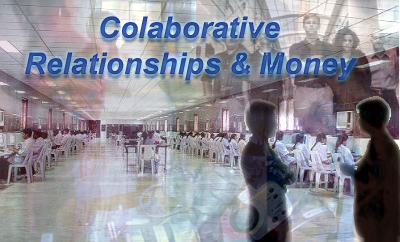 COLLABORATIVE
RELATIONSHIPS AND $$
COLLABORATIVE
RELATIONSHIPS AND $$
Independent production is collaboration. Somewhere buried in the show of the business is the creativity that allows it to flourish. And that creativity is always found in the marriage of people. People who speak the same language and have the same sensitivity and respect for one another. And this collaboration is usually with the producer, director, cinematographer and editor.
The producer and director do most if their collaboration during the pre production process, while the director and the cinematographer do theirs during the production process and finally the director and the editor complete the working creative relationships. Although the producer is there each and every step of the way encouraging and nurturing the quarterback (the director) to carry the ball (the vision) to a certain point, the collaboration is key. We hear a lot about the producer and the director, and the director and the cinematographer but a different kind of magic takes place during the editing process and the editor must be in synch as well. Filmmaking is about collaboration!
Steven Spielberg and Michael Kahn began in 1977 on Close Encounters of the Third Kind and together they work as one and think as one in finding the rhythm of the picture and the story telling. Thelma Schoonmaker (Gangs of New York) and Martin Scorsese have been working together since Raging Bull and have a unique relationship as Shoonmaker sees options in Scorsese’s material and their collaboration is quite keen. Filmmaking is about collaboration!
Because of a variety of reasons the picture editor today is becoming more important. Many producers don’t know how to produce the story being told. Many directors don’t know how to direct the story being told. And sometimes, the writer hasn’t written a story that can be told. So the editor is faced with making sense out of what there is in delivering a story. The rule book in editing is slowly getting thrown away as audiences are accepting more edits within a scene (MTV?). As directors and producers are more indecisive with their story telling, or the complexity of the project details the need there is more material being given to the editor so they can do more edits. And digital editing allows for more quick cuts in succession. Editors also are asked to move lines around to change a scene’s shape. Some time ago we would look at a project and see what was left out, now it is seeing how it is arranged.
What does this mean to producing? What it provides to the producer is the opportunity to correct mistakes that are made throughout the process of production. But what
it also does is extend the cost of the project as there is a direct correlation of cost to creativity.
“WHAT YOU DON’T DO IN PREPRODUCTION AFFECTS YOU IN PRODUCTION AND WHAT YOU DON’T DO IN PRODUCTION AFFECTS YOU IN POST PRODUCTION!” ARE MOVIES ONLY AT THE MOVIES?-MS


